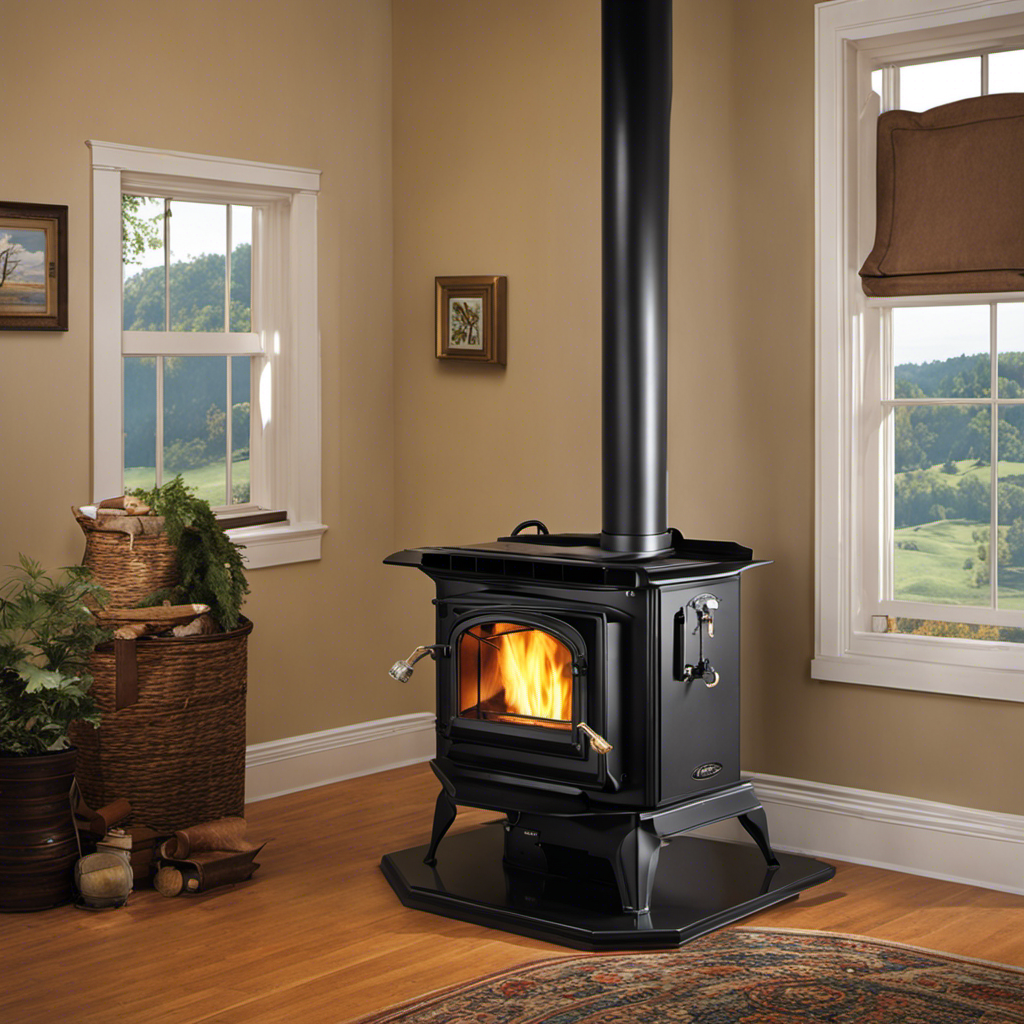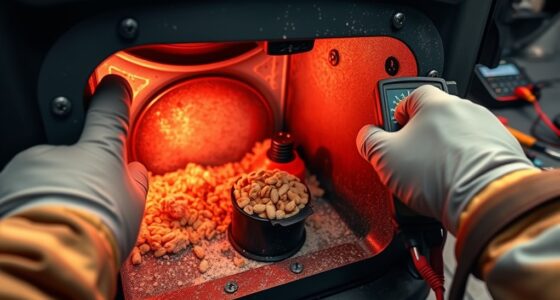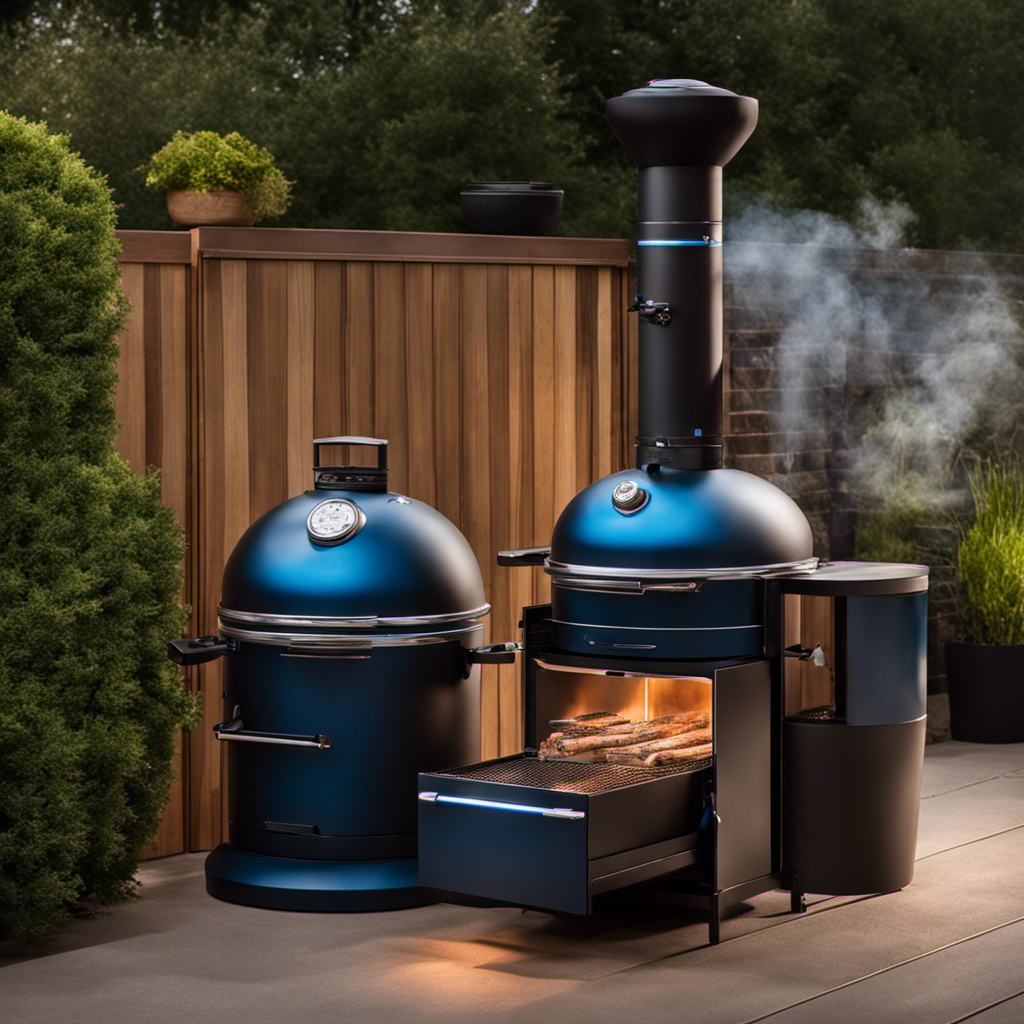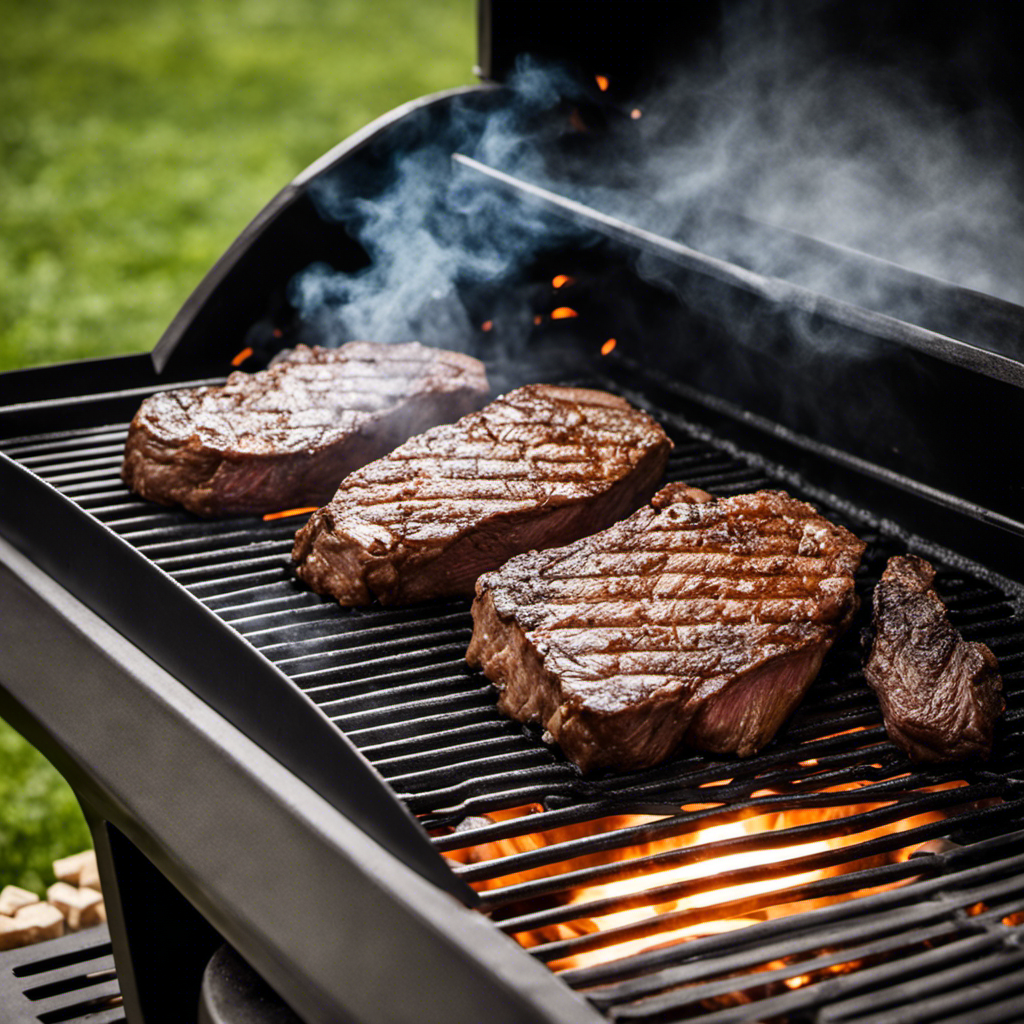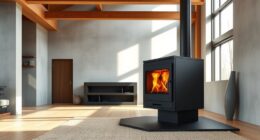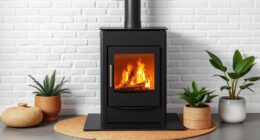Have you ever thought about the role of the vacuum switch in your Englander wood pellet stove? Allow me to explain it to you.
The vacuum switch plays a crucial role in ensuring the safe and efficient operation of your stove. In this article, we will dive into the inner workings of the vacuum switch, discuss its importance, and provide troubleshooting tips.
So, if you’re ready to optimize your stove’s performance, keep reading!
Key Takeaways
- The vacuum switch regulates the combustion process in wood pellet stoves.
- Regular maintenance and inspection of the vacuum switch are crucial for safe and efficient stove operation.
- Signs of a faulty vacuum switch include inconsistent heat output and difficulty in starting or maintaining a fire.
- Cleaning the vacuum switch regularly and following manufacturer’s instructions for maintenance helps ensure optimal performance and longevity.
Understanding the Vacuum Switch
If you’re wondering how the vacuum switch works on your Englander wood pellet stove, let me explain it to you.
The vacuum switch is a vital component that helps regulate the combustion process in your stove. It ensures that there is proper airflow through the combustion chamber by monitoring the vacuum pressure.
This pressure is created by the stove’s exhaust fan. The vacuum switch is responsible for detecting any issues with the vacuum pressure and signaling the control board to take appropriate action.
To ensure proper functioning, regular vacuum switch maintenance is essential. This includes checking for any blockages or leaks in the vacuum lines, cleaning or replacing the switch if necessary, and troubleshooting vacuum switch problems.
Understanding how the vacuum switch works is crucial in maintaining the optimal performance of your Englander wood pellet stove.
How the Vacuum Switch Works
The vacuum switch on your Englander wood pellet stove works by detecting changes in air pressure. It is a crucial component that ensures the safe and efficient operation of your stove.
The vacuum switch is connected to the exhaust system and monitors the air pressure within it. When the stove is turned on, the exhaust fan creates negative pressure, causing the vacuum switch to close. This closure signals to the stove’s control board that proper draft is established and the stove can ignite.
However, if the vacuum switch fails or is not functioning properly, it can lead to issues such as stove shutdown or failure to ignite. Regular maintenance of the vacuum switch, including cleaning and checking for any obstructions, is essential for its proper operation.
Troubleshooting the vacuum switch should be done if any issues arise, such as the stove not starting or shutting down unexpectedly. Understanding the importance of the vacuum switch is crucial for maintaining a safe and efficient wood pellet stove.
Importance of the Vacuum Switch
Regular maintenance of the vacuum switch is crucial for ensuring the safe and efficient operation of your wood pellet stove. This includes cleaning and checking for any obstructions. The vacuum switch plays a vital role in the functioning of your stove by monitoring the air pressure within the combustion chamber. If the pressure drops below a certain threshold, the vacuum switch signals the control board to shut down the stove, preventing potential hazards.
To troubleshoot a vacuum switch, start by inspecting the wiring connections for any loose or damaged wires. Additionally, ensure that the vacuum tube is free from any blockages or leaks. Regularly cleaning the vacuum switch and conducting visual inspections will help identify any potential issues early on.
A faulty vacuum switch can lead to various problems in the operation of your wood pellet stove. Proper maintenance of the vacuum switch is essential for the longevity and performance of your stove.
Signs of a Faulty Vacuum Switch
As a homeowner, it’s crucial to be aware of the symptoms of a malfunctioning vacuum switch in your wood pellet stove. These symptoms may include inconsistent heat output, difficulty in starting or maintaining a fire, or even the complete failure of the stove to ignite.
Regular inspections of the vacuum switch can help identify any issues early on, ensuring optimal performance and preventing potential damage.
If you encounter problems with your wood pellet stove, troubleshooting tips such as checking for loose connections, cleaning the switch, or testing its functionality can be useful in resolving the issue.
Symptoms of Malfunctioning Switch
If you notice the vacuum switch on your Englander wood pellet stove isn’t working properly, you’ll likely experience issues with the stove’s ignition or inconsistent pellet feed.
The vacuum switch plays a crucial role in the operation of your pellet stove, ensuring that the appropriate amount of negative pressure is maintained in the combustion chamber. When the switch malfunctions, it can disrupt this balance and lead to a range of problems.
To troubleshoot a faulty vacuum switch, you can start by checking the electrical connections, ensuring they are secure and free from any damage. Additionally, you should inspect the switch for any signs of wear or corrosion and clean it regularly to maintain its performance.
Regular maintenance and inspection of the vacuum switch are essential to ensure the proper functioning of your Englander wood pellet stove.
Importance of Regular Inspection
Regular inspection of the vacuum switch on your Englander wood pellet stove is of utmost importance. Neglecting this crucial maintenance task can lead to potential risks and problems down the line. The vacuum switch plays a vital role in ensuring the safe and efficient operation of your stove. It is responsible for detecting the presence of negative pressure in the stove’s combustion chamber, which helps regulate the flow of pellets and maintain proper combustion.
By regularly inspecting the vacuum switch, you can identify any signs of wear, damage, or malfunction early on. This allows you to address the issue promptly and prevent any further complications. Failure to inspect the vacuum switch can result in poor stove performance, decreased efficiency, increased fuel consumption, and even potential safety hazards such as carbon monoxide leaks or fires.
Transitioning into troubleshooting tips for homeowners, it is essential to know how to identify and address common issues with the vacuum switch to ensure the optimal functioning of your Englander wood pellet stove.
Troubleshooting Tips for Homeowners
To ensure optimal functioning of your stove, it’s important to familiarize yourself with troubleshooting tips for addressing common issues. Here are some key points to keep in mind when maintaining your pellet stove and troubleshooting heating issues:
-
Clean the stove regularly: A build-up of dust and debris can affect the stove’s performance. Regular cleaning of the burn pot, ash pan, and exhaust system is essential.
-
Check the fuel supply: Make sure the hopper is properly filled with high-quality pellets. Low-quality pellets or a clogged fuel line can cause heating issues.
-
Inspect the igniter and combustion blower: Ensure that the igniter is working properly and the combustion blower is clean and functioning.
By following these maintenance and troubleshooting tips, you can keep your pellet stove running efficiently.
Now, let’s move on to discussing the troubleshooting of vacuum switch issues.
Troubleshooting Vacuum Switch Issues
When troubleshooting vacuum switch issues on your Englander wood pellet stove, it’s important to check for any loose connections. Start by inspecting the wiring that connects to the vacuum switch. Look for any frayed or damaged wires and ensure they are securely connected. If you find any loose connections, tighten them using a screwdriver or pliers.
Additionally, check the vacuum switch for any signs of wear or damage. If the switch appears to be damaged, it may need to be replaced. Troubleshooting vacuum switch wiring can be a complex task, so if you’re unsure or uncomfortable with electrical work, it’s best to consult a professional.
Maintaining and cleaning the vacuum switch is essential for proper stove operation and will be discussed in the next section.
Maintaining and Cleaning the Vacuum Switch
Now that we have discussed troubleshooting steps for the vacuum switch on my Englander wood pellet stove, let’s move on to maintaining and cleaning this important component.
To ensure proper functioning, it is crucial to keep the vacuum switch clean and free from any debris or obstructions. Cleaning techniques for the vacuum switch may vary depending on the model, so it is best to consult the manufacturer’s manual for specific instructions.
In general, the switch can be gently wiped clean with a soft cloth or brush. Take care not to damage any sensitive components during the cleaning process. By regularly cleaning and maintaining the vacuum switch, you can prevent potential issues and ensure its longevity.
Now, let’s move on to adjusting the vacuum switch settings.
Adjusting the Vacuum Switch Settings
When it comes to the optimal vacuum switch settings for my wood pellet stove, there are a few key points to consider.
First, it’s important to understand the role of the vacuum switch in regulating the flow of air and ensuring proper combustion.
Second, troubleshooting the vacuum switch can help identify and resolve any potential issues, such as a faulty switch or incorrect settings.
Lastly, recognizing the importance of the vacuum switch in maintaining the efficiency and safety of the stove is crucial for ensuring its optimal performance.
Optimal Vacuum Switch?
To ensure optimal performance, you should check if the vacuum switch on your Englander wood pellet stove is functioning properly. The vacuum switch plays a crucial role in the stove’s operation by sensing the negative pressure created by the exhaust blower. It is responsible for activating and deactivating the stove’s various components based on the vacuum levels.
To set the optimal vacuum switch settings, consult your stove’s manual for the recommended values. These settings may vary depending on factors such as altitude and stove model.
If you encounter any problems with the vacuum switch, troubleshooting is necessary. Common issues include a faulty switch, clogged hoses, or improper installation. By addressing these problems, you can ensure that your wood pellet stove operates efficiently and safely.
Now, let’s move on to troubleshooting the vacuum switch without delay.
Troubleshooting Vacuum Switch
If you’re experiencing issues with your stove’s vacuum switch, troubleshooting is necessary.
The vacuum switch is a crucial component of your stove, responsible for detecting the presence or absence of negative pressure in the combustion chamber.
To troubleshoot the vacuum switch, start by checking the electrical connections to ensure they are secure.
Next, inspect the vacuum hose for any signs of damage or blockage. Clean the hose and the vacuum port if necessary.
Additionally, test the switch using a multimeter to ensure it is functioning correctly.
Regular maintenance of the vacuum switch is essential to prevent problems. Clean the switch periodically to remove any debris or residue that may affect its performance.
Importance of Vacuum Switch
Ensure you understand the importance of maintaining the vacuum switch in your stove. The vacuum switch plays a critical role in the proper functioning of your englander wood pellet stove. It is a safety device that monitors the air pressure within the stove’s combustion chamber.
Understanding the vacuum switch components is essential for troubleshooting vacuum switch problems. The switch consists of a diaphragm, a pressure tube, and electrical contacts. When the vacuum in the chamber drops below a certain level, the diaphragm activates the electrical contacts, allowing the stove to ignite and operate.
If the vacuum switch malfunctions, it can lead to issues such as the stove not igniting or shutting down unexpectedly. Proper maintenance and regular cleaning of the vacuum switch are crucial to ensure its optimal performance.
Upgrading to a programmable vacuum switch can provide added convenience and control over your stove’s operation.
Upgrading to a Programmable Vacuum Switch
When upgrading to a programmable vacuum switch, you’ll have more control over the operation of your Englander wood pellet stove. This upgrade offers several benefits and can help resolve common issues that arise with the standard vacuum switches.
One of the main advantages of a programmable vacuum switch is the ability to customize the vacuum levels based on your specific needs. This ensures optimal performance and efficiency of your wood pellet stove.
Additionally, a programmable switch allows you to set different vacuum levels for different operating modes, such as startup, idle, and shutdown. This level of control helps prevent issues like flameouts or excessive fuel consumption.
Benefits of a Reliable Vacuum Switch
As an expert in the field, I can confidently discuss the benefits of a reliable vacuum switch in relation to ensuring proper ventilation, preventing overheating issues, and enhancing fuel efficiency.
The vacuum switch plays a crucial role in maintaining a well-ventilated environment, allowing for efficient combustion and reducing the risk of harmful emissions. By constantly monitoring the vacuum levels, it prevents overheating by automatically shutting down the stove when necessary, ensuring the safety and longevity of the system.
Additionally, a reliable vacuum switch optimizes fuel efficiency by regulating the airflow, thereby maximizing the heat output and minimizing fuel consumption.
Ensures Proper Ventilation
To maintain proper ventilation in your Englander wood pellet stove, make sure the vacuum switch is functioning correctly. The vacuum switch plays a crucial role in ensuring the stove operates efficiently and safely.
Regular maintenance of the vacuum switch is essential to prevent any issues that may arise. Start by inspecting the switch for any visible damage or loose connections. If there are any signs of damage, it’s important to replace the switch immediately.
Troubleshooting vacuum switch issues involves checking the electrical connections, testing the switch with a multimeter, and cleaning or replacing the switch if necessary.
Prevents Overheating Issues
Make sure you regularly check and maintain your stove’s ventilation system to prevent overheating issues.
A properly functioning ventilation system is crucial for preventing damage and maintaining temperature control in your stove.
Overheating can cause serious damage to the stove’s components and even pose a safety hazard.
By regularly inspecting and cleaning the ventilation system, you can ensure that air is flowing properly and that the stove is able to release excess heat. This helps to prevent overheating and allows the stove to operate at optimal efficiency.
In addition to preventing damage, maintaining the ventilation system also enhances fuel efficiency by ensuring that the stove is able to burn fuel efficiently and effectively.
Enhances Fuel Efficiency
After discussing how the vacuum switch prevents overheating issues in my Englander wood pellet stove, let’s now delve into its role in enhancing fuel efficiency.
The vacuum switch plays a crucial part in optimizing fuel consumption and energy efficiency. Here are some key points to consider:
- The vacuum switch constantly monitors the pressure within the stove’s combustion chamber.
- By maintaining the optimal pressure range, the switch ensures that the stove burns the wood pellets efficiently, minimizing waste.
- It regulates the flow of air and fuel, creating a balanced combustion process that maximizes heat output while minimizing fuel consumption.
With the vacuum switch’s control over the stove’s combustion process, it helps you get the most out of your wood pellets, reducing the frequency of refueling and saving you money in the long run.
Now, let’s address some common questions about vacuum switches without further ado.
Common Questions About Vacuum Switches
One of the most frequently asked questions about vacuum switches is how they work with wood pellet stoves. Vacuum switches are crucial components in wood pellet stoves as they ensure proper airflow and combustion.
These switches are designed to detect the presence of negative pressure or vacuum inside the stove’s combustion chamber. If the vacuum level drops below a certain threshold, the switch activates and allows the stove to continue operating.
However, vacuum switch maintenance is essential for optimal performance. Cleaning the switch regularly and checking for any blockages or damage can help prevent potential problems. Troubleshooting vacuum switch problems may involve checking the wiring connections, inspecting the switch for wear, or adjusting the switch’s sensitivity.
Expert Tips for Optimizing Vacuum Switch Performance
To optimize your vacuum switch performance, it’s important to regularly clean and inspect the switch for any potential issues. Here are some expert tips for maintaining and troubleshooting your vacuum switch:
-
Clean the switch: Remove any dirt, debris, or dust that may have accumulated on the switch. This can be done using a soft brush or compressed air.
-
Check for proper alignment: Ensure that the vacuum switch is properly aligned and securely fastened to the stove. A misaligned switch can cause performance issues.
-
Test the switch: Use a multimeter to test the functionality of the switch. Check for continuity and proper operation when the vacuum levels change.
-
Replace if necessary: If the vacuum switch is faulty or damaged beyond repair, it’s important to replace it with a new one. Consult the manufacturer’s guidelines for the correct replacement part.
Frequently Asked Questions
Can I Replace the Vacuum Switch on My Englander Wood Pellet Stove With a Different Brand?
No, it is not recommended to replace the vacuum switch on your Englander wood pellet stove with a different brand. Different brands may have different specifications and may not be compatible with your stove.
How Often Should I Clean and Maintain the Vacuum Switch on My Wood Pellet Stove?
To troubleshoot a malfunctioning vacuum switch on my wood pellet stove, I need to know how often to clean and maintain it. Proper cleaning techniques are crucial for keeping the switch in good working order.
Can a Faulty Vacuum Switch Cause Other Problems With My Wood Pellet Stove?
A faulty vacuum switch on a wood pellet stove can cause various problems. It can lead to issues with ignition, fuel delivery, and overall performance. Troubleshooting and identifying signs of a faulty vacuum switch is crucial for proper stove operation.
Can I Adjust the Vacuum Switch Settings to Increase the Efficiency of My Wood Pellet Stove?
I can adjust the vacuum switch settings to increase the efficiency of my wood pellet stove. Troubleshooting vacuum switch problems is important to ensure optimal performance and prevent any issues with the stove.
Can I Upgrade My Existing Vacuum Switch to a Programmable One for Better Control Over My Wood Pellet Stove?
Upgrading the vacuum switch to a programmable one can provide better control over your wood pellet stove. The benefits of a programmable vacuum switch include increased efficiency, improved temperature regulation, and enhanced overall performance.
Conclusion
In conclusion, the vacuum switch on my Englander wood pellet stove serves a vital purpose. It is responsible for detecting negative pressure in the combustion chamber, allowing the stove to operate efficiently. By monitoring the vacuum levels, the switch ensures proper airflow and prevents issues like overheating or poor combustion.
If you notice any signs of a faulty vacuum switch, it is crucial to troubleshoot and address the problem promptly. Upgrading to a programmable vacuum switch offers added convenience and control. A reliable vacuum switch is essential for optimal performance and hassle-free operation of your wood pellet stove.
Growing up surrounded by the vast beauty of nature, Sierra was always drawn to the call of the wild. While others sought the comfort of the familiar, she ventured out, embracing the unpredictable and finding stories in the heartbeat of nature.
At the epicenter of every remarkable venture lies a dynamic team—a fusion of diverse talents, visions, and passions. The essence of Best Small Wood Stoves is crafted and refined by such a trio: Sierra, Logan, and Terra. Their collective expertise has transformed the platform into a leading authority on small wood stoves, radiating warmth and knowledge in equal measure.

